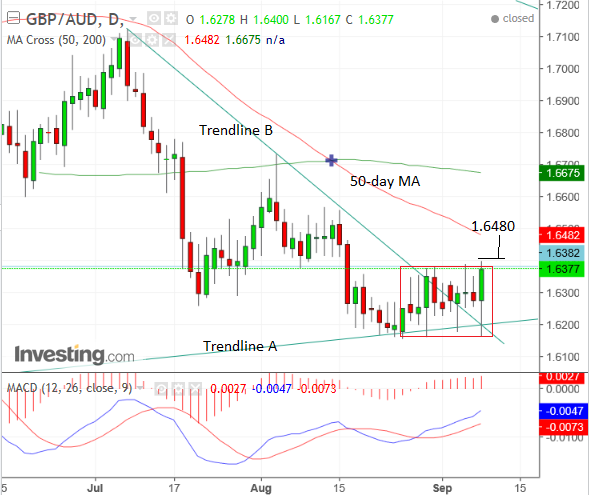5 Day Pound-to-Australian Dollar Rate Technical Forecast, Events and Data to Watch

There is a possibility GBP/AUD could break higher based on our technical chart studies while a deteriorating Australian fundamental outlook adds to a slight bullish bias to the outlook.
The Pound-to-Australian Dollar exchange rate has been trading in a range-bound, sideways consolidation on the daily chart.
It was in a strong downtrend before it found support at the major trendline (labeled 'A') situated just below the 1.61 lows.

Unable to break below the trendline the exchange rate has stalled and started going sideways instead.
It has moved through a downsloping trendline (labeled 'B') effectively breaking above it.
We see a chance of a break higher developing from out of the sideways range.
Such a move would probably reach up to the level of the 50-day moving average at 1.6480 and would be confirmed by a break above 1.6415.
Moving averages can provide tough levels of support and resistance, however, and it is likely that the pair will stall at the level of the 50-day MA.
A break lower is possible too, but given the break through Trendline B we see the bias now favouring an upside breakout.
Get up to 5% more foreign exchange by using a specialist provider by getting closer to the real market rate and avoid the gaping spreads charged by your bank for international payments. Learn more here.
Data and Events to Watch for the Australian Dollar
The bullish technical turnaround in GBP/AUD is a reflection of recent dovish commentary from the Australian central bank, which suggests it will not be raising interest rates for a long time, as well as the recent run of below-par Australian economic data.
"Next week’s labor market numbers aren’t expected to help the currency because weaker labor market activity was seen in the manufacturing and service sectors according to the latest PMI reports. If that’s the case, AUD may retreat off its highs," said BK Asset Managment's Kathy Lien in a discussion of next weeks releases.
Aussie labour market data is out 21.30 BST on Wednesday, September 13.
Employment is supposed to show a 19.2k rise in August and the Unemployment rate is forecast to remain stuck on 5.6%.
Other events include the release of NAB Business Confidence data at 21.30 on Monday and commentary from assistant governor Debelle at 19.15 on Wednesday.
Data and Events to Watch for the Pound
It looks set to be a busy week for the Pound with the Bank of England announcing their rate decision on Thursday, as well as data showing inflation, unemployment and wage growth.
The Bank of England is not widely expected to announce a change in policy on Thursday at 12.00 BST, and according to Canadian investment bank TD Securities, the voting is expected to show a 6-2 split in favour of keeping interest rates unchanged.
BK Asset Managment's Kathy Lien, highlights the continued weakness in "consumer spending and inflation," as a reason to expect the BOE not to, "veer away from its cautious tone."
Forecasters are expecting a rise in inflation when data is released at 09.30 on Tuesday, September 12.
The headline rate is expected to rise to 2.8% year-on-year from 2.6% in August 2016, and core inflation to 2.5% from 2.4% respectively.
Without a corresponding rise in wages, higher inflation is likely to weigh on the Pound rather than support it, as it simply results in everyone being poorer.
Which is why data out on Wednesday, September 10, is likely to be so important, as it will show the state of the UK labour market and wages. Expectations are for earnings to rise by 2.3% in August.
A beat on expectations in this number could prove to be supportive of Sterling.
Remember to keep an eye on politics at the start of the week as parliament intend to vote on the government's great repeal Brexit bill.
The Labour party are currently against the bill, which they say gives too much autonomous power to ministers to make changes to EU law once it is transposed into the UK legal system.
A small number of conservative MPs are also against the bill which means, the vote could be close given the government's slim majority.
A failure of the bill to pass, would cause volatility for the Pound but it is not clear in which direction.
The increased uncertainty caused by the Bill's failure would argue for Sterling to devalue owing to the increased uncertainty such an outcome would bring.
However, we see little chance of Conservative lawmakers rebelling against the Government; the party's slim majority means there is little appetite for an election which they could well lose considering Labour and the Conservatives are near even in the polls.




